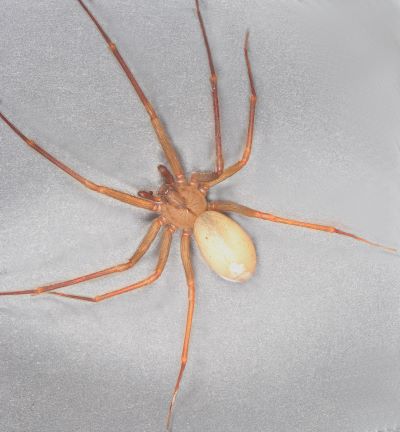Brown Recluse (Loxosceles reclusa)
The brown recluse is not native to Montana. Its native range is southeastern Nebraska south through Texas and east to approximately eastern Georgia, stopping well before the Savannah River on the eastern border of the state. “Brown recluse bites” are frequently misdiagnosed in medicine, particularly in western states where the spider is not present. To date, no brown recluse spiders have been positively identifed by trained arachnologists or entomologists in Montana.
Description

Figure 1: Male brown recluse. Photo by L. Kerzicnik
The brown recluse is ¼- to ½-inch long. It has six eyes that are arranged in three pairs of two behind its head, while most spiders have eight eyes. It has a “violin” pattern on its first segment, the cephalothorax. However, this is not a reliable character because it can fade under certain conditions and it also mimics similar patterns on other spiders. Identifcation of a brown recluse or suspected brown recluse must be done by a trained arachnologist or entomologist.
Facts About the Brown Recluse and Other Spiders in Montana
- It is extremely unlikely that any “diagnosed” spider bite from this area is from a brown recluse.
- The spider is often erroneously blamed for bacterial-caused rashes and lesions that have nothing to do with spiders or spider bites but, rather, are caused by some other wound or puncture that allows bacteria to enter the body.
- The most common cause for such necrotic lesions in areas of the country where brown recluse spiders are not found (such as Montana) is MRSA (Methicillin Resistant Staphylococcus aureus infection).
- The venom of brown recluse spiders contains a component called sphingomyelinase-D, which creates mild to severe necrotic lesions in the immediate area of the bite.
- Reactions to the toxin in the venom delivered from the brown recluse bite mimic several other types of medical issues, including bacterial infections, chemical and allergic reactions, lymphoma, and several others.
- The misdiagnosis of brown recluse bites can have serious consequences for certain medical conditions that go undetected.
- It is possible for a brown recluse spider to hitchhike or appear in Montana through shipments and boxes from areas where it is native.
To minimize the risk of spider bites, take caution when working in crawl spaces, garages,
the laundry room, and
in areas that are not often encountered. In general, bites are rare from spiders.
The only way to confrm that a
spider is responsible for a suspected bite is if the specimen is captured and identifed
or with a good-quality
photo.
To learn more about the topics discussed on this page, contact the Schutter Diagnostic Lab. If you suspect an infestation on your property, contact your local extension agent, the Schutter Diagnostic Lab at Montana State University, or the Montana Department of Agriculture.
This October 2022 fact sheet is also available as a Printable PDF (394KB).
Disclaimer: These recommendations are provided only as a guide. It is always the pesticide applicator’s responsibility, by law, to read and follow all current label directions for the specific pesticide being used. The authors and Montana State University assume no liability resulting from the use of these recommendations. The Montana State University Extension Service is an ADA/EO/AA/Veteran’s Preference Employer and Provider of Educational Outreach.
